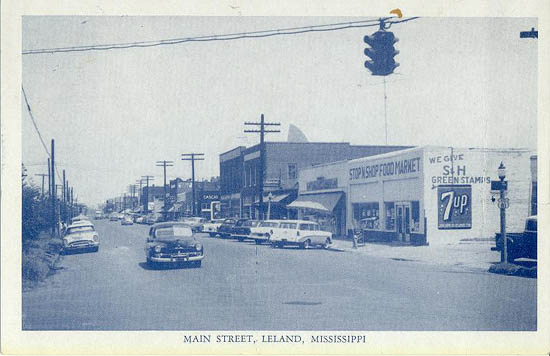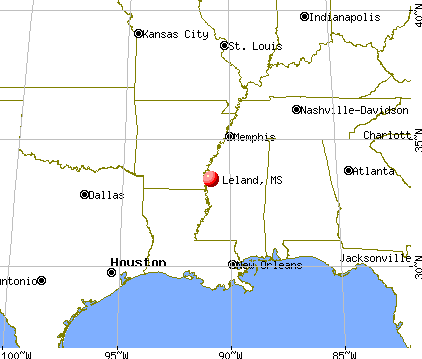
From Harper’s Magazine, "The Resegregation of a Southern School," by Douglas A. Blackmon, on September 1992 -- Another long hot summer has ended in the Mississippi Delta, and the students in my hometown are coming back to Leland High School. Seventy-five seniors are expected to graduate this year, sixty-one of them black and fourteen white. I entered the first grade in the Leland school system in 1970?Leland’s first year of fully integrated classes. That spring, sixty white faces peered out from the Leland senior-class portrait. In 1982, when my class was the first to graduate after twelve full years of black and white children studying together, only two dozen whites remained in a class of just under ninety.
Despite the fact that the number of white graduates diminished slowly during the time I was there, the class of 1982’s graduation symbolized the culmination of the struggle to integrate public education in a state long defined by racial hatred. Our rite of passage was Mississippi’s rite of passage, and when my classmates ventured into the world, Mississippians who believed in the ideal of integration hoped they had sown the seeds of a more equal and tolerant society.

But now, ten years later, hardly anyone, black or white, even remembers that dream. Integration here in Leland and across much of Mississippi has largely failed. The Delta school system is almost as segregated today as it was in 1968, although now it is characterized by mostly black public systems and all- white private institutions. In many towns, there are virtually no whites left in the public system.
At Leland High, extracurricular activities are fading as community support diminishes among whites. The school newspaper, started in the 1970s by my oldest brother, vanished several years ago. Academic clubs are struggling. When a newspaper story recently reported that Leland High might no longer be able to afford a yearbook, most townsfolk just rolled their eyes.
What is most noticeably absent in Leland’s schools is the biracial community spirit that initially made them some of the most integrated in the Delta–an achievement that was supposed to be a dramatic step toward integrating all of society. While desegregation succeeded in easing overt racial hostility and opening up Leland’s restaurants, motels and libraries, black and white children today face one another across the same awkward racial divide that we did twenty years ago. And they leave high school on opposite sides of an economic gulf almost as wide as before. Yet Leland has become a place where few blacks or whites find it objectionable–or even odd–that there are racially divided schools. And almost no one believes it will ever change. Integration, born amid outcries of both hope and excoriation, has withered in virtual silence.
Leland is a rather typical Mississippi Delta town of 6,000 residents, mostly merchants, planters, and laborers. The population is–and has been for as long as anyone recalls–about 60 percent black. My family moved there in 1967, into an old, rambling yellow house in a white middle-class neighborhood. Like the rest of Mississippi, Leland inched its way toward integration only at the steady prod of the federal government. The tide turned on October 29, 1969, when the Supreme Court issued a sweeping ruling that required almost immediate integration in Leland and twenty-nine other Mississippi school districts. I began the first grade the following fall.
After the Court’s ruling, a flood of hysterical white Mississippi families fled to newly crated private segregationist academies–schools with Confederate colonel mascots and rebel flag logos. But in Leland, a biracial coalition of school leaders and parents, my own included, began a campaign to encourage whites to keep their children in public school. They handed out stickers at school-board meetings that read, “Think Positive,” and published a full-page ad in the local paper with the names of more than 200 white parents who promised that their children would remain in the public-school system. In that first year, Leland retained about half its white students–a remarkable achievement for a Delta town.
Those were curious times of racial exploration for me. I was completely unaware of the turmoil that had preceded my first day of school, and as best as I can recall, it was a topic that our teachers never encouraged us to discuss. My parents didn’t talk about it either, but they somehow drilled into me the notion that there was one evil perhaps greater than any other, this thing called “prejudice.”
I wasn’t sure exactly what it meant. I just knew I was supposed to avoid it, and that my friends from church who went to “the academy” were somehow tainted by it. The word was so ominous and omnipresent that it terrified me. Occasionally, a black classmate would suddenly ask me: “Are you prejudiced?” “Of course not,” I would quickly respond, while thinking, “It’s the private-school people who are prejudiced.”
But I was receiving other signals that were confusing. I became fast friends with a black classmate, Donald Richardson, and at some point in the fourth grade we began talking about visiting each other’s homes to combine our GI Joe collections. His parents were schoolteachers, just like my mother, and his grandfather was a retired school principal.
Donald and I never did visit each other, though. He’s a band director at Leland High now, and recently I asked him why he though we never spent time at each other’s homes–or, for that matter, why black and white classmates almost never visited each other’s homes. He remembers that time the same way I do–no specific recollection of which teacher or parent or classmate had said it, but the sense of getting a clear message: visiting each other was “not a good idea.”
By the time I was in junior high school, segregation was evident in almost every facet of my life except the classroom. I earned merit badges in an all-white Boy Scout troop and played Little League baseball on an all-white team, the Planters. My friends and I spent our summers at segregated swimming pools, and our families had picnics in segregated parks. Blacks and whites even played on opposite sides of Lake Monocnoc, on the edge of town.
At school, racial tensioned characterized the daily dynamic. Fistfights on the playground between whites and blacks were routine, and being harassed by blacks as I walked home through their neighborhood after school was so common that I was amazed later to learn that anyone else had grown up differently. The school stopped sponsoring senior proms, student banquets, senior trips, and other social gatherings long before I was old enough to know what they were.

Some of the reluctance to integrate children outside of the classroom came, ironically, from desegregation supporters. Many of these parents believed that the immediate goal was simply to integrate the schools. The feared that sanctioning socializing between black and white students might cause anxious white parents to pull their children out of the schools altogether. But much of the hesitation about social integration was triggered by far more extreme sentiments. Blacks were seething with the anger of decades of humiliation and years of white obstructionism, even after segregation was illegal. Whites were gripped by misgivings about integration: everything from the innocuous “decline in quality education” to more bizarre concerns that whites would no longer be able to compete athletically, or that lecherous black boys would attack innocent white girls.
The anger and fear I witnessed daily, I now realize, reflected a complex set of emotions being vented at dinner tables in every part of town. During the first years of integration, dedicated black and white adults worked within the institutions of church, jobs and city hall to resolve the fear and anger. But over the long haul, they left it to their children, for the most part, to fight it out around the swing sets.

Despite the racial tensions, we whites were well served by the integrated public schools. We gained from the rough-and-tumble mix of cultures and, I think, were strengthened by the confrontations it sparked. Most of the whites in the class of 1982–generally from wealthier, more educated families than the blacks–finished college and never returned to Leland. My black classmates did not fare as well. A few went to college and then to cities in the North or West; several others went into the military. But the basic threshold of “success” for blacks in the Delta is leaving it, and most of my classmates never did.
Recently, I went back to Leland to see what had become of my classmates who stayed behind during the decade wince we graduated. I found that being black in the Delta typically still means a lifetime of barely scraping by in a place where factory jobs are few and the only big industry, farming, is controlled by an old fashioned white elite. Brandon Taylor, who broke my undefeated spelling bee record when he entered our class in the sixth grade, briefly played professional basketball in Europe. Now he’s back in the Delta struggling to make a living.

Elaine and Eloise Chillis, one of two sets of fraternal twins in my class, have worked since graduation for Delta Pride, a catfish company in Indianola notorious for its oppressive working conditions. With experience and good performance, they told me they can look forward to eventually making top pay at the plant: $5.30 an hour. By Delta standards, they are fairly successful, each with steady work and one beautiful boy. They don’t particularly want to leave. Elaine and Eloise were precisely the kind of children–smart but deprived of opportunity–whom integration was supposed to help. No one spelled out exactly what integration was supposed to accomplish at the time it was ordered, but there was overwhelming sense that it was going to bring genuine change for the Elaine’s an Eloise’s of this country.
Instead, integration became a game of numbers that fell far short of any real effort to secure civil–and human–rights. In the tremendous and exhausting struggle to prove on paper that public schools no longer discriminated, the larger question of how truly to unite a divided society was forgotten. “We didn’t have a really specific vision,” my father told me recently. “We thought we were in the midst of some very profound changes. In retrospect, it may have been an over expectation.”

Naive or not, the goals of school integration were doomed when the community leadership that had worked so hard to sustain the public schools slowly melted away: the newspaper editor who had weathered scorn for his pro-integration positions moved to another town; the white school superintendent and the top black school administrator who had worked tirelessly behind the scenes to promote understanding retired; the white school-board members, who despite their political conservatism believed that good public schools were essential to a small town, resigned after years of frustration.
By why didn’t others come forward to replace them? Why are there no present-day counterparts to the white leaders who supported school integration twenty years ago? Part of the reason, perhaps, is that the moral urgency of the late 1960s–the sense of rapid social change that compelled people to take strong stands–is gone.

For white Mississippians who considered themselves enlightened, the idea of sending their children to all-white private schools twenty-five years ago was taboo. The academies held the torch in those days for all of the old Southern evils against which America was railing. But today, those crude segregationist trappings have largely fallen away. Most of the smallest academies have closed, and their students have been consolidated into larger, better schools. Supporters of these schools extol their “quality” educational environment in nonracial terms, and the student body may well include the children of one or two black professionals.
Personal convenience has prevailed over community good. The moral conviction that integrated my school has given way to an indifference and numbness–the same numbness that allowed me (and most white Deltans) to accept abject black poverty just a stone’s throw away from our own homes. Today, many of the children of the early white graduates of Leland’s integrated public schools are attending private academies.

In the black community, too, almost no one is complaining about the resegregation of Leland’s schools. In recent months, black activists have been more focused on keeping alive the traditions of the old all-black high school, which now houses grades four, five and six. Last fall, the building’s white principal wanted to replace some athletic trophies from the days before integration in a display case with the work of current students. The black community was outraged.
This acute nostalgia reflects a growing sense among some blacks that the cost of giving up schools that they controlled may have been greater than the gains of integration. Before desegregation, black children learned in institutions that, despite all the adversity these schools faced, succeeded entirely because of the efforts and talents of black adults. The schools were woven into the fabric of the community and were a sanctuary from the racial denigration that marked life outside. Integration changed all that, removing blacks from top policy-making positions in the schools and raising racial questions about every faculty promotion and every student disciplinary action.

Perhaps the lesson to be drawn from a place like Leland is that destroying the formal institutions of racism has little effect on integrating people’s day-to-day personal lives–or on advancing economic equality. The economic situation for blacks in the Delta today has changed little despite the good intentions of the people who pushed for diverse schools in Leland.
Maybe that was inevitable. Maybe it’s impossible to cause dramatic change in only a quarter of a century. Maybe desegregation was doomed from its first day. But I can’t help thinking that those are little more than excuses. The preachers and teachers and aldermen and grocers and research scientists and high-minded farmers of today’s Leland could re-create the coalition that first integrated my school. They could talk boldly not just about schools, but about the broader issues of race and poverty and opportunity. I don’t know whether such an effort would assure Elaine’s and Eloise’s baby boys something more than the catfish plant, but it’s the only thing that might. (source: Slavery By Another Name, Blackmon, Douglas)


No comments:
Post a Comment